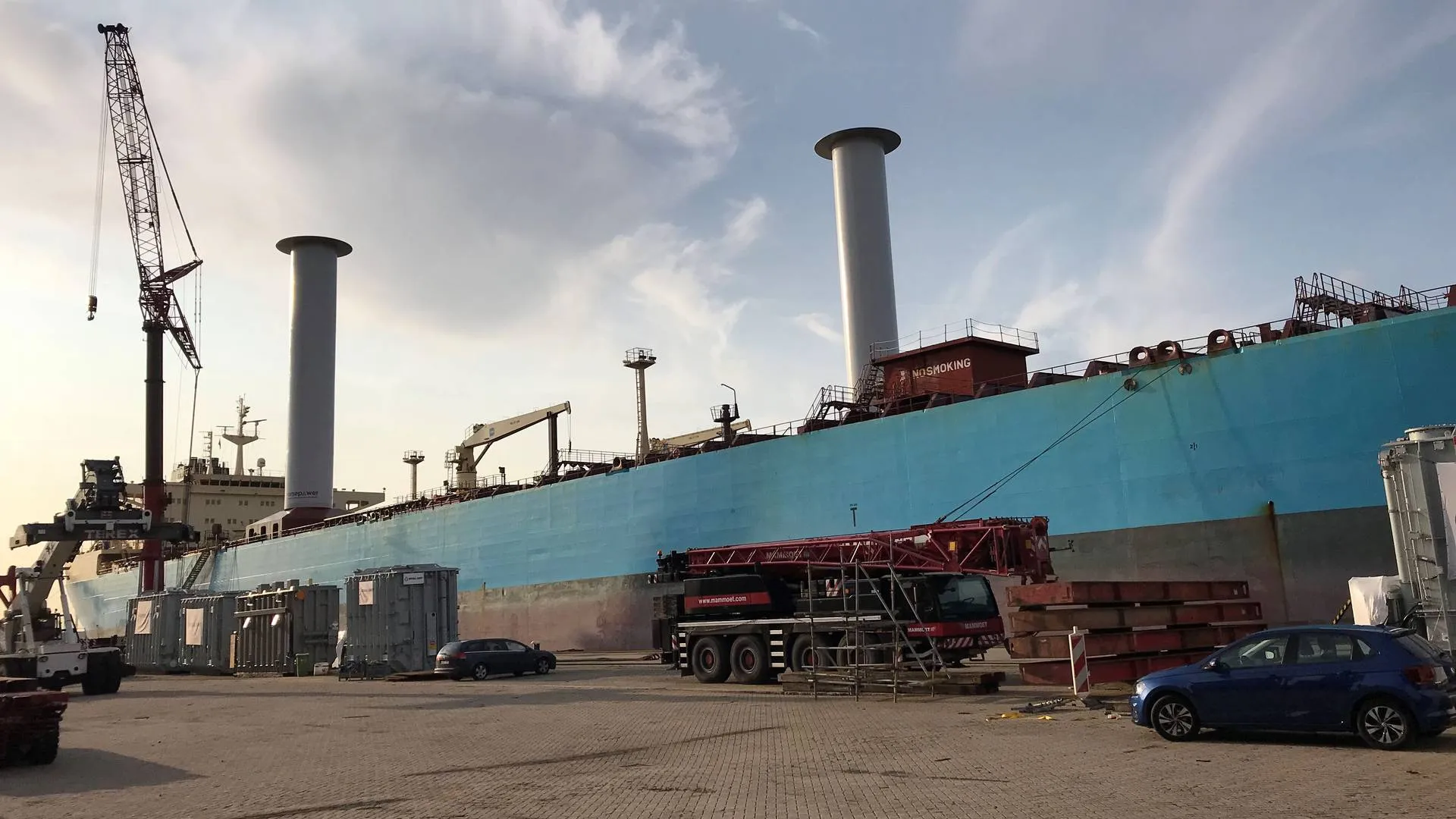
The vessel Maersk Pelican has made its first sailing with two giant, concrete pipes that stand out against the landscape.
Late Thursday evening, the vessel departed the port of Rotterdam, where Maersk Tankers installed two 30 meter high “sails” on board.
This is the culmination of 18 months of work preparing to test wind technology as a way to save on fuel and reduce CO2 emissions.
This technology is the next step in a development which has been underway for some time
TOMMY THOMASSEN, CHIEF TECHNICAL OFFICER, MAERSK TANKERS
Tommy Thomassen, Chief Technical Officer at Maersk Tankers, believes several years of discussion about wind technology in the industry now have the potential to develop into concrete evidence that the technology is mature.
“This technology is the next step in a development which has been underway for some time. We have taken the step of reducing our emissions and fuel over several years, and this creates the opportunity to create a step change on that journey. We have calculated an annual average improvement of 7-10 percent so we expect a lot of that,” says Thomassen to WPO.
Watch the video of the two sails here.
Longer test phase begins
Norsepower supplied and installed the two cylinder-shaped sails measuring 30 meters high and five meters wide. The pipes function by rotating and thereby generating forward propulsion.
Now a test phase of at least eight months begins, where the vessels will be tested under differing sailing conditions such as how heavily the vessel is loaded. Conditions in relation to shorter and longer journeys are also being investigated while the right wind patterns on the journeys must also be found.

Photo: PR-foto: Maersk Tankers
In this process, several factors are crucial for Maersk Tankers to move on with the technology, says Thomassen.
For one thing, it needs to be proved that the sails can be operated both in port terminals and close waters. The handling of the sails must also be carried out securely, both in relation to maintenance and staff on board the vessel.
“Equally as important is it that we get the fuel savings potential. We are quite comfortable with it, but now we have to test it,” says Thomassen.
When will sails be installed on a larger share of Maersk Tankers’ fleet?
“We will do that if the reduction in fuel consumption is demonstrated. As these are prototypes we have installed, they are too expensive to be a commercial product. So our suppliers have the task of making the price more competitive. This is the parallel work which needs to be carried out at the same time as we are testing.”
The project is primarily financed by UK fund ETI while Shell Shipping & Maritime and Norsepower are on board with the project. According to Thomassen, Maersk Tankers’ investment in the project consists primarily of making the vessel, staff and time available.
Mostly for the large ships
The ship Maersk Pelican is a 109,600 dwt large product tanker vessel of the type LR2 (Long range).
And the large vessels are precisely where Maersk Tankers finds the wind technology most useable, Thomassen explains.
“It has something to do with the ships’ fuel consumption, but also their sailing patterns as they typically sail on longer routes. For the smaller vessels such as handysize and Maersk Tankers’ Intermediate fleet there is a need for a lower price on the sails before the technology becomes attractive.”
Even though wind technology has been debated as a potential way of lowering the impact on the environment in recent years, use of the technology has been quite limited. A reality that becomes even more pronounced when looking at the fact that the supplier Norsepower has only installed its technology aboard just three ships worldwide.
However, Thomassen believes that the technology has only just entered a scale that makes it compelling for a larger part of the shipping industry.
“As with all technology, it needs to be developed and tested and it’s only now that you get units that are large enough to make it interesting. The previous experiments we have seen in the industry have been too heavy and difficult to install aboard,” he says and continues.
“But with the materials and control systems that are behind here, we can now get a technology aboard, which despite the size, is relatively light and which can give a large effect.”
Maersk Pelicans’ routes will remain the same as previously, he informs. The ship will therefore sail on the main routes for LR2 ships, which typically run from Rotterdam to the Red Sea, the Persian Gulf and the Far East.
In future, the journey planning will now take wind conditions into consideration as well.
English Edit: Lena Rutkowski & Ida Jacobsen
Bad bunker compels suppliers in Singapore to rely on contract trick
Maersk Tankers wants to optimize using ideas and data





